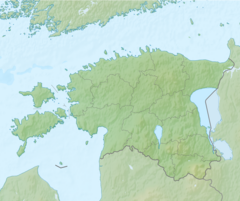Jägala concentration camp
| Jägala concentration camp | |
|---|---|
| Concentration camp | |
 Kalevi-Liiva Memorial to extermination camp victims (1942–1943) | |
| Coordinates | 59°25′N 25°14′E / 59.42°N 25.24°E |
| Operational | 1942–1943 |
Jägala concentration camp was a labour camp of the Estonian Security Police and SD during the German occupation of Estonia during World War II. The camp was established in August 1942 on a former artillery range of the Estonian Army near the village of Jägala, Estonia. It existed from August 1942 to August 1943. Aleksander Laak, an Estonian, was appointed by SS-Sturmbannführer Ain-Ervin Mere of Group B of the Estonian Security Police to command the camp with Ralf Gerrets as assistant.[1][2]
Officially Jägala was a "labour education camp" or "Arbeitserziehungslager" for forced forestry and field workers.[3] The camp housed Jews deported to Estonia from other countries,[4] including Lithuania, Czechoslovakia, Germany and Poland. About 3,000 Jews who were not selected for work at their arrival at Raasiku railway station were taken directly from the station and shot at the nearby Kalevi-Liiva extermination site.[2]
The camp never held more than 200 prisoners and had a short life span of several months.[4] In November 1942 it was reported that the camp held 53 men and 150 women.[3] Most of the prisoners were eventually transferred to Tallinn Central Prison starting with about half of the prisoners moved in December 1942 and the rest in June and July.[3] By August 1943 the camp was closed and most of the remaining inmates were shot.[2] Several sick prisoners were shot at the Jägala camp while about 15 hospitalised prisoners were sent to Kalevi-Liiva to be executed, Laak also killed three women, one of them his sex slave; the camp was then dismantled by September 1943.[5]
The estimates for the number of killed at Jägala concentration camp vary. Soviet investigators concluded that 2,000-3,000 were killed in Jägala and Kalevi-Liiva taken together, but the number 5,000 (as determined by the Extraordinary State Commission in 1944) was written into the verdict.[6][7]
In modern sources, the number 10,000[clarification needed] occurs.[2][8][9] However, Estonian International Commission for Investigation of Crimes Against Humanity and estimates of scholars place the number of total Jewish victims in Estonia during 1941-1944 around 8,500.[4][10]
See also
- The Holocaust in Estonia
- Klooga concentration camp
- Vaivara concentration camp
- List of Nazi-German concentration camps
References
- ^ Maripuu, Meelis (2006). "Annihilation of Czech and German Jews in Estonia in 1942-1943". In Hiio, Toomas (ed.). Estonia 1940–1945. Reports of the Estonian International Commission for the Investigation of Crimes Against Humanity (PDF). Meelis Maripuu, Indrek Paavle. Tallinn: Estonian Foundation for the Investigation of Crimes Against Humanity. pp. 705–715. ISBN 9949-13-040-9. Archived from the original (PDF) on 20 July 2011. Retrieved 23 November 2010.
- ^ a b c d "PHASE II : THE GERMAN OCCUPATION OF ESTONIA IN 1941–1944" (PDF). Estonian International Commission for Investigation of Crimes Against Humanity. Archived from the original (PDF) on 20 July 2011. Retrieved 13 August 2010.
- ^ a b c Weiss-Wendt, p237
- ^ a b c Weiss-Wendt, Anton (30 June 2009). Murder Without Hatred: Estonians and the Holocaust (Religion, Theology, and the Holocaust). Syracuse University Press. p. 351. ISBN 978-0-8156-3228-3.
- ^ Weiss-Wendt, p238
- ^ Hiio, Toomas; Meelis Maripuu. "Ülevaade juutide tapmisest Eesti territooriumil asunud laagrites" (in Estonian). Estonian Ministry of Culture. Retrieved 13 August 2010.
- ^ "Juudid pidasid Kalevi-Liiva koonduslaagri komandandi üle omakohut". Eesti Ekspress. 29 July 2008. Archived from the original on 10 March 2012. Retrieved 14 August 2010.
- ^ Kaasik, Peeter (28 May 2010). "Holocaust in Estonia". Estonica. Retrieved 13 August 2010.
- ^ "Komisjon: 20.000 juudi hukkamine Eestis pole tõendatud". Virumaa Nädalaleht (in Estonian). 20 September 2004. Archived from the original on 13 April 2014. Retrieved 13 August 2010.
- ^ e.g. Wolfgang Benz Handbuch des Antisemitismus: Judenfeindschaft in Geschichte und Gegenwart, Volume 1. 2008. S 111.

